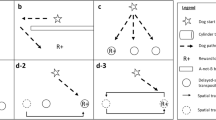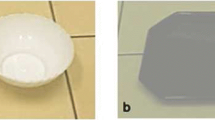Abstract
Optimal cognitive ability is likely important for military working dogs (MWD) trained to detect explosives. An assessment of a dog’s ability to rapidly learn discriminations might be useful in the MWD selection process. In this study, visual discrimination and reversal tasks were used to assess cognitive performance in Labrador retrievers selected for an explosives detection program using a modified version of the Toronto General Testing Apparatus (TGTA), a system developed for assessing performance in a battery of neuropsychological tests in canines. The results of the current study revealed that, as previously found with beagles tested using the TGTA, Labrador retrievers (N = 16) readily acquired both tasks and learned the discrimination task significantly faster than the reversal task. The present study confirmed that the modified TGTA system is suitable for cognitive evaluations in Labrador retriever MWDs and can be used to further explore effects of sex, phenotype, age, and other factors in relation to canine cognition and learning, and may provide an additional screening tool for MWD selection.
Similar content being viewed by others
References
Boutet I, Ryan M, Kulaga V, McShane C, Christie LA, Freedman M, Milgram NW (2005) Age-associated cognitive deficits in humans and dogs: a comparative neuropsychological approach. Prog Neuro-psychopharmacol Biol Psychiatry 29(3):433–441
Carere C, Locurto C (2011) Interaction between animal personality and animal cognition. Curr Zool 57(4):491–498
Cotman CW, Head E (2008) The canine (dog) model of human aging and disease: dietary, environmental and immunotherapy approaches. J Alzheimers Dis 15(4):685–707
Dufort RH, Guttman N, Kimble GA (1954) One-trial discrimination reversal in the white rat. J Comp Physiol Psych 47(3):248–249
Gazit I, Terkel J (2003) Explosives detection by sniffer dogs following strenuous physical activity. Appl Anim Behav Sci 81:149–161
Goddard ME, Beilharz RG (1986) Early prediction of adult behavior in potential guide dogs. Appl Anim Behav Sci 15:247–260
Hare B, Tomasello M (2006) Behavioral genetics of dog cognition: human-like social skills in dogs are heritable and derived. In: Ostrander E, Giger U, Lindblad-Toh K (eds) The dog and its genome. Cold Spring Harbor Laboratory Press, New York, pp 497–514
Herrmann E, Call J, Hernàndez-Lloreda MV, Hare B, Tomasello M (2007) Humans have evolved specialized skills of social cognition: the cultural intelligence hypothesis. Science 317(5843):1360–1366
Houpt KA, Willis M (2001) Genetics of behavior. In: Ruvinsky A, Sampson J (eds) The genetics of the dog. CABI Publishing, Wallingford, pp 371–400
Kendler HH, Lachman R (1958) Habit reversal as a function of schedule of reinforcement and drive strength. J Exp Psychol 55(6):584–591
Kim YK, Lee SS, Oh SI, Kim JS, Suh EH, Houpt KA, Lee CL, Lee HJ, Yeon SC (2010) Behavioral reactivity of the Korean native Jindo dog varies with coat color. Behav Process 84:568–572
Lai ZC, Moss MB, Killiany RJ, Rosene DL, Herndon JG (1995) Executive system dysfunction in the aged monkey: spatial and object reversal learning. Neurobiol Aging 16(6):947–954
Lambach Y, Herrmann E, Call J, Tomasello M (2009) Physical and social cognition in domestic dogs: a comparative study. J Vet Behav: Clin Appl Res 4(2):49–50 (Abstract)
Lefebvre D, Giffroy JM, Diederich C (2009) Cortisol and behavioural responses to enrichment in military working dogs. J Ethol 27:255–265
Maejima M, Inoue-Murayama M, Tonosaki K, Matsuura N, Kato S, Saito Y, Weiss A, Murayama Y, Ito S (2007) Traits and genotypes may predict the successful training of drug detection dogs. Appl Anim Behav Sci 107:287–289
Milgram NW, Head E, Weiner E, Thomas E (1994) Cognitive functions and aging in the dog: acquisition of nonspatial visual tasks. Beh Neuro 1:57–68
Milgram NW, Head E, Zicker SC, Ikeda-Douglas CJ, Murphey H, Muggenburg B, Siwak C, Tapp D, Cotman CW (2005) Learning ability in aged beagle dogs is preserved by behavioral enrichment and dietary fortification: a two-year longitudinal study. Neurobiol Aging 26:77–90
Rapp PR (1990) Visual discrimination and reversal learning in the aged monkey (Macaca mulatta). Behav Neurosci 104(6):876–884
Rooney NJ, Gaines SA, Bradshaw JWS, Penman S (2007) Validation of a method for assessing the ability of trainee specialist search dogs. Appl Anim Behav Sci 103:90–104
Sinn DL, Gosling SD, Hilliard S (2010) Personality and performance in military working dogs: reliability and predictive validity of behavioral tests. Appl Anim Behav Sci 127:51–65
Slabbert JM, Odendaal JSJ (1999) Early prediction of adult police dog efficiency: a longitudinal study. Appl Anim Behav Sci 64:269–288
Svartberg K (2002) Shyness–boldness predicts performance in working dogs. Appl Anim Behav Sci 79:157–174
Svartberg K, Tapper I, Temrin H, Radesater T, Thorman S (2005) Consistency of personality traits in dogs. Anim Behav 69:283–291
Tapp PD, Siwak CT, Estrada J, Head E, Muggenburg BA, Cotman CW, Milgram NW (2003) Size and reversal learning in the beagle dog as a measure of executive function and inhibitory control in aging. Learn Mem 10(1):64–73
Wilsson E, Sundgren PE (1998) Behavior test for eight-week old puppies- heritabilities of tested behaviour traits and its correspondence to later behavior. Appl Anim Behav Sci 58:151–162
Acknowledgments
This work was funded by a contract to K2 Solutions, Inc. from the United States Office of Naval Research.
Conflict of interest
The authors declare that they have no conflict of interest.
Ethical standards
This research complies with the current laws of the United States of America and was reviewed and approved by the NCSU Institutional Animal Care and Use Committee (IACUC) and the DoD US Army Medical Research and Materiel Command (USAMRMC) Animal Care and Use Review Office (ACURO). NCSU research animal facilities are inspected semiannually by the NCSU IACUC, and the CVM is accredited by the Association for the Assessment and Accreditation of Laboratory Animal Care International (AAALAC, International).
Author information
Authors and Affiliations
Corresponding author
Rights and permissions
About this article
Cite this article
Lazarowski, L., Foster, M.L., Gruen, M.E. et al. Acquisition of a visual discrimination and reversal learning task by Labrador retrievers. Anim Cogn 17, 787–792 (2014). https://doi.org/10.1007/s10071-013-0712-1
Received:
Revised:
Accepted:
Published:
Issue Date:
DOI: https://doi.org/10.1007/s10071-013-0712-1




